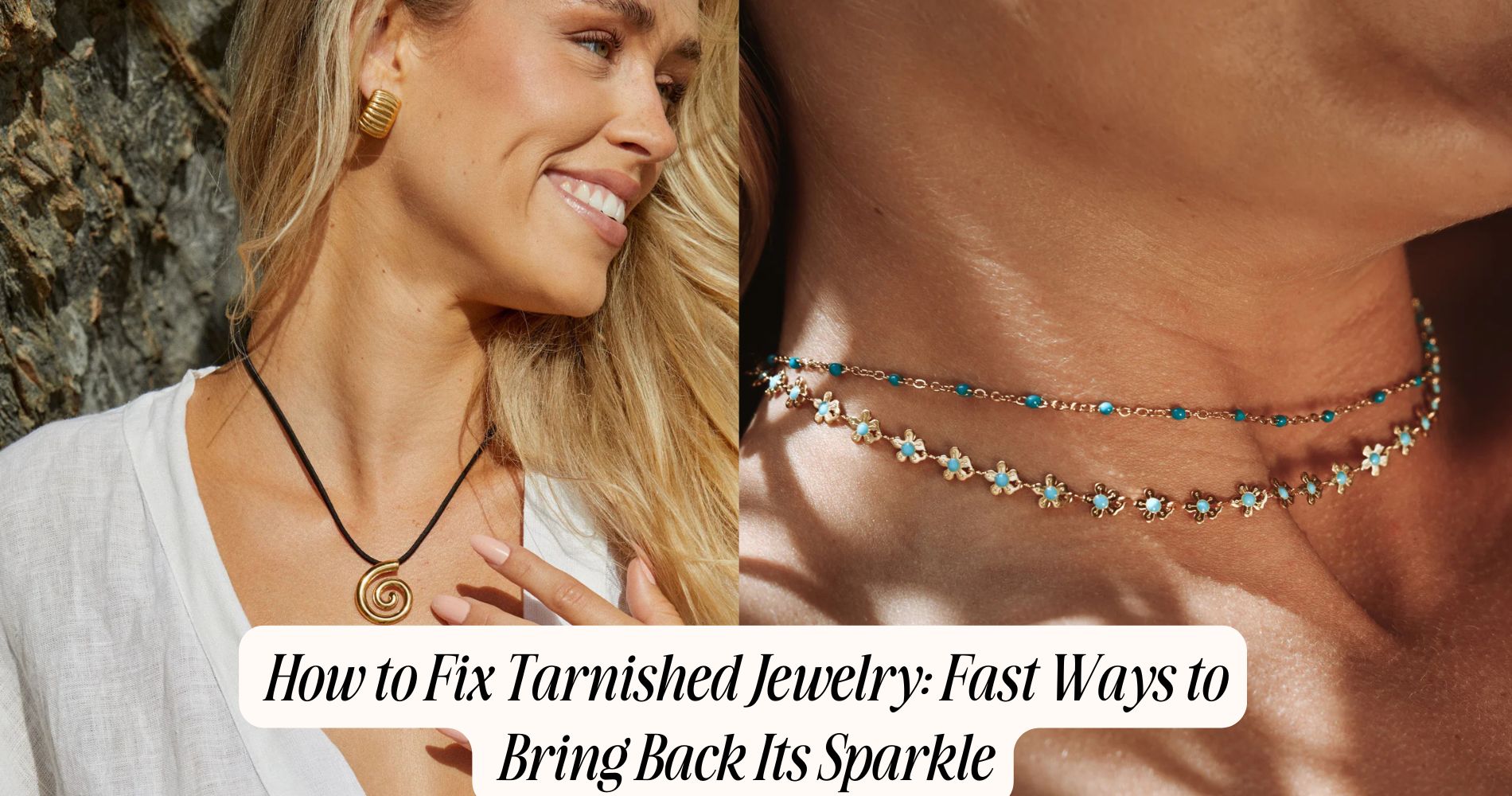
How to Fix Tarnished Jewelry: Fast Ways to Bring Back Its Sparkle
Wondering how to fix tarnished jewelry? Start with a simple baking soda paste—mix three parts baking soda with one part water and gently rub it on the piece using a soft cloth. For a deeper clean, soak your jewelry in a solution of half a cup of white vinegar and two tablespoons of baking soda for two to three hours, then rinse and dry thoroughly. You can also try lemon juice or non-gel toothpaste for gentle scrubbing. Proper storage and regular cleaning can prevent future tarnish, ensuring your jewelry stays radiant. For bold statement pieces, check out our Chunky Jewelry collection and keep them shining like new.
Understanding Tarnish
Tarnish often appears unexpectedly on your favorite pieces of jewelry, leaving them looking dull and lifeless. This unsightly film isn't just a cosmetic issue; it's the result of chemical reactions occurring between your jewelry materials and environmental elements.
For example, metals like silver react with sulfur compounds in the air, forming silver sulfide, which causes that dark tarnish you see.
Understanding the specific materials in your jewelry can help you anticipate tarnishing. If you own pieces made from silver, copper, or brass, you're more likely to encounter tarnish due to their susceptibility to these reactions.
On the other hand, materials like gold and platinum are far less prone to tarnishing, making them more durable choices for everyday wear.
Humidity, body oils, and exposure to chemicals in cosmetics or cleaning products can accelerate tarnishing. By knowing how these factors interact with your jewelry, you can take preventative steps, ensuring your favorite pieces don't lose their luster.
Staying informed about the chemistry behind tarnish empowers you to care for your jewelry effectively, keeping it looking beautiful and radiant for years to come.
Common Cleaning Supplies
To restore your tarnished jewelry, knowing the right cleaning supplies is key. You don't need to invest in expensive products; often, simple household items work wonders. Two of the most effective supplies are baking soda and white vinegar.
Baking soda acts as a gentle abrasive, perfect for polishing metals without causing scratches. Mix a tablespoon of baking soda with a few drops of water to create a paste. Apply it to the tarnished areas using a soft cloth or sponge, and gently rub in circular motions. Rinse thoroughly with warm water and dry with a lint-free cloth.
White vinegar is another powerhouse for jewelry cleaning. Its acidic nature can dissolve tarnish effectively. For a quick soak, combine equal parts of white vinegar and water in a bowl. Submerge your jewelry for about 15-20 minutes, then use a soft toothbrush to remove any remaining tarnish. Rinse well and dry completely.
With these common cleaning supplies at your disposal, you can bring back the shine to your favorite pieces. Just remember to test any method on a small area first, especially if your jewelry contains delicate stones or finishes.
Quick Home Remedies
When you're in a pinch and need to restore your jewelry quickly, several effective home remedies can save the day. One popular method is the baking soda paste.
Simply mix three parts baking soda with one part water to form a paste. Use a soft cloth or your fingers to gently rub the paste onto the tarnished areas, then rinse thoroughly and dry.
Another fantastic option is a vinegar solution. Combine half a cup of white vinegar with two tablespoons of baking soda in a bowl.
Soak your jewelry in this mixture for about two to three hours. Rinse it off and pat it dry to reveal a sparkling finish.
You might also consider the toothpaste method. Apply a small amount of non-gel toothpaste onto a soft cloth and gently rub it over the tarnished spots.
Rinse with water and dry.
Lastly, lemon juice can be a powerful ally. Dip a cloth in lemon juice and wipe down your jewelry.
The acidity will help dissolve tarnish. Whatever method you choose, you'll be amazed at how quickly your jewelry regains its luster!
Professional Cleaning Options
For those seeking a thorough and reliable restoration of their jewelry, professional cleaning options offer a level of expertise that home remedies can't match. When you consult a jeweler, they'll assess your pieces and recommend the best cleaning techniques tailored to the specific materials and conditions of your jewelry.
Many jewelers use ultrasonic cleaners, which employ high-frequency sound waves to dislodge dirt and tarnish from intricate designs without damaging the metal. This method is particularly effective for items with hard-to-reach crevices.
Additionally, steam cleaning is another professional technique that can revive your jewelry's sparkle, utilizing high-pressure steam to lift away grime gently.
It's essential to get jeweler recommendations before proceeding. A trusted professional won't only clean your jewelry but also provide valuable insights into proper care and maintenance. Following their guidance can help you avoid potential mishaps that may arise from DIY attempts.
Preventing Future Tarnish
To keep your jewelry looking its best, you need to adopt proper storage techniques and establish a regular cleaning routine.
Storing items in anti-tarnish pouches or airtight containers can greatly reduce exposure to the elements that cause tarnish.
Additionally, a consistent cleaning schedule will help maintain their shine and prevent buildup, ensuring your pieces remain as stunning as the day you bought them.
Proper Storage Techniques
Storing your jewelry properly is essential in preventing tarnish and maintaining its luster. To start, invest in high-quality jewelry boxes that offer a soft, protective lining. This cushioning helps to prevent scratches and minimizes exposure to air, which is a major cause of tarnishing.
Next, consider using anti tarnish pouches for your most cherished pieces. These specialized pouches contain materials that absorb moisture and prevent tarnish, keeping your jewelry in pristine condition. For added protection, wrap individual pieces in soft cloth before placing them in the boxes or pouches. This extra layer can further shield your jewelry from scratches and tarnishing agents.
Additionally, avoid storing your jewelry in damp areas like bathrooms, as humidity can accelerate tarnish. Instead, choose a cool, dry location. Remember to keep your jewelry away from direct sunlight, which can cause fading and damage over time.
Finally, when you wear your jewelry, make sure to clean it gently and store it correctly afterward. By following these proper storage techniques, you'll not only prevent tarnish but also guarantee that your jewelry continues to sparkle and shine beautifully for years to come.
Regular Cleaning Routine
Keeping your jewelry clean is essential in preventing future tarnish and guaranteeing its lasting beauty. Establishing a regular cleaning routine can make a significant difference in maintaining your pieces. Aim to clean your jewelry at least once a month, but if you wear it daily, consider increasing the cleaning frequency to weekly. This will help minimize the buildup of dirt, oils, and tarnish.
When it comes to product selection, choose gentle cleaners specifically designed for your jewelry type. For silver, a mild silver polish or a solution of warm water and dish soap can work wonders. For gold and platinum, avoid abrasive materials; instead, opt for a soft cloth and a gentle cleaner. Always test any new product on a small, inconspicuous area first to guarantee it won't damage the finish.
Don't forget to dry your jewelry thoroughly after cleaning, as moisture can contribute to tarnishing. By incorporating these practices into your routine, you'll not only keep your jewelry looking its best but also prolong its life, allowing you to enjoy its sparkle for years to come.
Regular care is key to preventing tarnish and maintaining your treasured pieces.
Caring for Different Materials
Caring for different materials in jewelry requires a tailored approach to maintain their beauty and integrity.
First, let's talk about gold maintenance. Gold is relatively resistant to tarnish, but daily wear can still dull its shine. To keep your gold jewelry looking its best, gently clean it with a mixture of warm water and mild dish soap. Use a soft cloth or a soft-bristled toothbrush to reach intricate details. Rinse thoroughly and dry it with a clean, soft towel.
Now, onto silver care. Silver tarnishes more easily due to its reaction with air and moisture. To combat this, store your silver pieces in airtight bags or anti-tarnish pouches.
When it's time for cleaning, use a silver polish or a homemade paste of baking soda and water. Apply it gently with a soft cloth, then rinse and dry. Avoid abrasive materials that could scratch your silver.
When to Seek Help
When you're faced with severe damage to your jewelry, it's essential to assess whether DIY fixes will suffice or if it's time to call in the experts.
If your piece shows deep scratches, broken clasps, or significant tarnishing that you can't manage, consider professional cleaning services for a thorough restoration.
Severe Damage Assessment
Sometimes, jewelry can sustain severe damage that goes beyond simple tarnish. When you notice deep scratches, cracks, or loose stones, it's essential to conduct a detailed damage evaluation. Look for tarnish indicators such as discoloration, pitting, or a dull finish. These signs can often accompany more serious issues, revealing underlying problems with the metal or stone settings.
If your piece has bent or broken components, like clasps or links, it's a clear signal that you should seek professional help. Attempting DIY repairs on severely damaged items could lead to further degradation, potentially resulting in irreversible loss of value or beauty.
Pay close attention to how the jewelry feels; if it seems fragile or sounds off when you gently tap it, that's a red flag.
Remember, the integrity of your jewelry is paramount, especially if it contains precious gems or intricate designs. It's better to be cautious than to risk exacerbating the damage.
Professional Cleaning Services
If your jewelry shows signs of tarnish that simple cleaning can't resolve, it may be time to contemplate professional cleaning services. Experts in jewelry restoration techniques possess the knowledge and tools to revive your pieces without risking damage.
When you notice persistent tarnishing, scratches, or dullness that regular cleaning methods fail to address, seeking professional help can be a smart choice.
The benefits of professionals extend beyond just a shiny finish. They can identify the specific materials in your jewelry and tailor their cleaning methods accordingly.
Techniques like ultrasonic cleaning or steam cleaning effectively remove grime and tarnish while preserving the integrity of delicate stones and metals.
Additionally, professionals can often repair minor damages, such as bent prongs or loose stones, ensuring your jewelry looks as good as new.
Frequently Asked Questions
Can I Use Baking Soda on All Types of Jewelry?
You can't use baking soda on all jewelry types. While it's effective for some metals, it may scratch delicate pieces like gemstones. Explore other jewelry cleaning alternatives for safer, more effective results tailored to your collection.
How Often Should I Clean My Jewelry?
You should clean your jewelry every few weeks, depending on wear frequency. Incorporating jewelry maintenance tips, regular cleaning prevents tarnishing and buildup, ensuring brilliance. Adjust the cleaning frequency based on your lifestyle and specific pieces' needs.
Is Tarnish Harmful to My Skin?
Tarnish itself isn't harmful to your skin, but it can cause irritation if you have skin sensitivity. Regular cleaning prevents tarnish effects that might lead to discomfort, so keep your jewelry sparkling and irritation-free.
Can Sunlight Cause Tarnish on Jewelry?
Yes, sunlight exposure can cause tarnish on jewelry, especially on silver. For effective jewelry maintenance, store your pieces in dark, cool places and avoid prolonged sunlight to minimize tarnishing and maintain their shine.
What Should I Do With Broken or Damaged Jewelry?
When dealing with broken or damaged jewelry, explore various repair options like soldering or re-stringing. For significant issues, consider professional jewelry restoration to restore your pieces to their original beauty and functionality.
Conclusion
By following these tips, you can easily restore your tarnished jewelry to its former glory. Whether you opt for quick home remedies or professional cleaning, keeping your pieces sparkling is within reach. Remember to prevent future tarnish by storing your jewelry properly and caring for different materials appropriately. If your jewelry still lacks its shine after trying these methods, don't hesitate to seek help from a professional. With a little effort, your favorites can shine bright again!

























Leave a comment
This site is protected by hCaptcha and the hCaptcha Privacy Policy and Terms of Service apply.